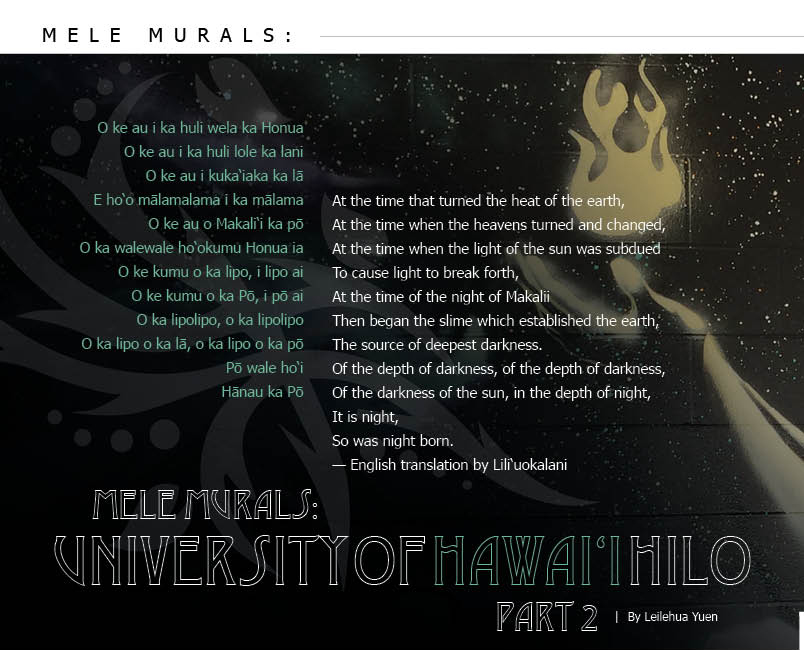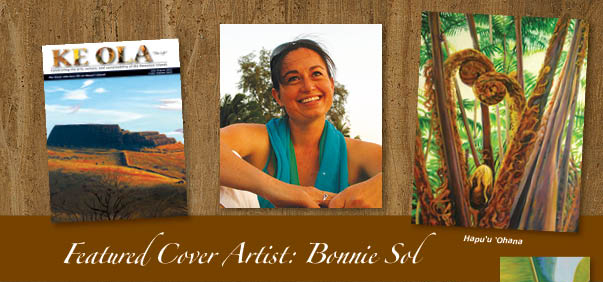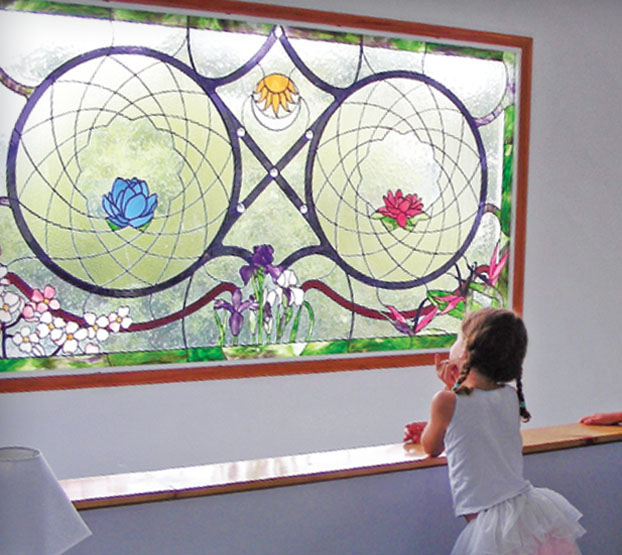
Inspiring Visions in Glass: Artist Calley O’Neill Teams with Stained Glass Artisan Lamar Yoakum
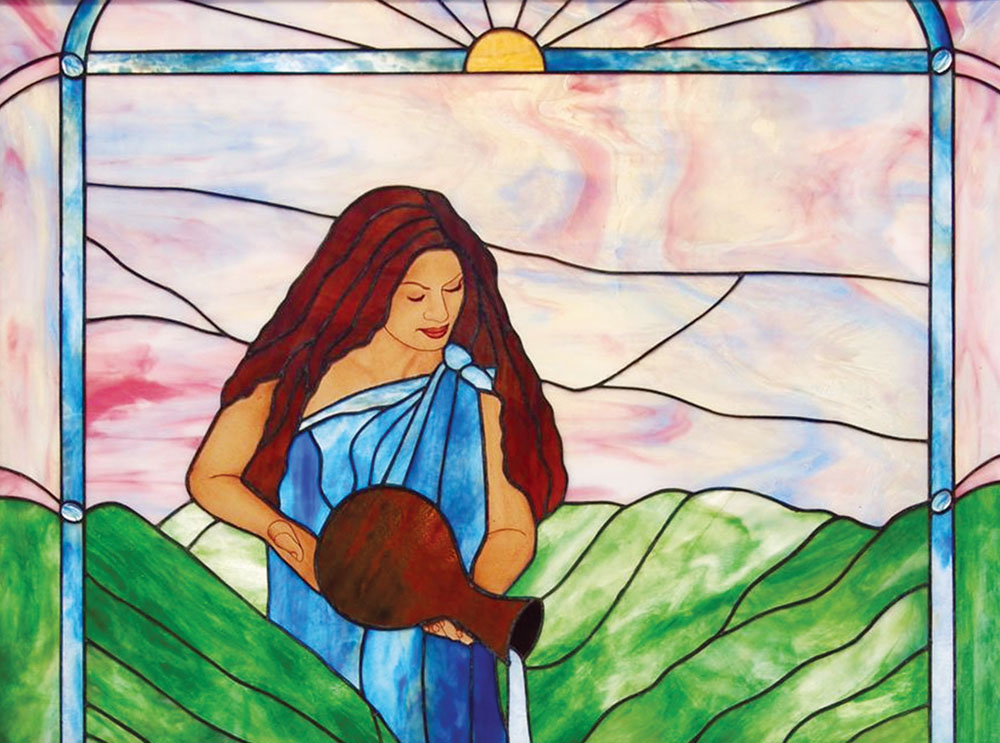
By Catherine Tarleton
If eyes are windows to the soul, then windows must be the eyes of a house’s soul, particularly a house of God, where stained glass windows cast cascading colors to illuminate the people.
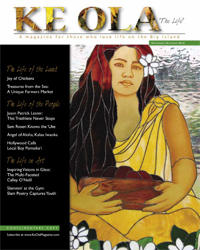
In the quiet little chapel in Waimea’s Catholic Church of the Annunciation, the Madonna and Child shine down from tall peaked walls. She wears a lei po’o, and a royal blue robe streams across one shoulder. On other walls, she gazes heavenward, but here, mother and child look down, as if to acknowledge a prayer.
The windows were created by the Waimea team of artist Calley O’Neill and artisan Lamar Yoakum. Their “firstborn,” the windows inspired a partnership that has continued to grow and flourish in the years since, as Yokomo Stained Glass and Mosaic.
O’Neill is already well known for her realistic-mythical paintings like The Three Muses, and murals such as Keanakāko‘i and E Mau Na Waiwai O Hawai‘i, at the Kings’ Shops. Her diverse work also includes a kaleidoscopic collection of mandalas, generally circular, geometric designs, traditionally used in healing and meditation. O’Neill’s mandalas often focus on specific themes, such as endangered species, and can also be custom-made for individual intentions.
The versatile and multi-faceted artist works, too, in a less-traditional way, in partnership with Rama, an Asian bull elephant in the Oregon Zoo! Rama’s handlers discovered he enjoys painting with his trunk. Rama, called the “Ambassador for the Endangered Ones,” lays down washes or broad brush strokes of color to which O’Neill adds foreground figures and detailed borders. Calley was inspired by this elephant (a story in itself) and endeavored to work with him. The result of their collaboration is the Rama Exhibition, a traveling education project to raise awareness and seek help for earth’s endangered species, schduled for completion in 2011. For more information, visit www.TheRamaExhibition.org.
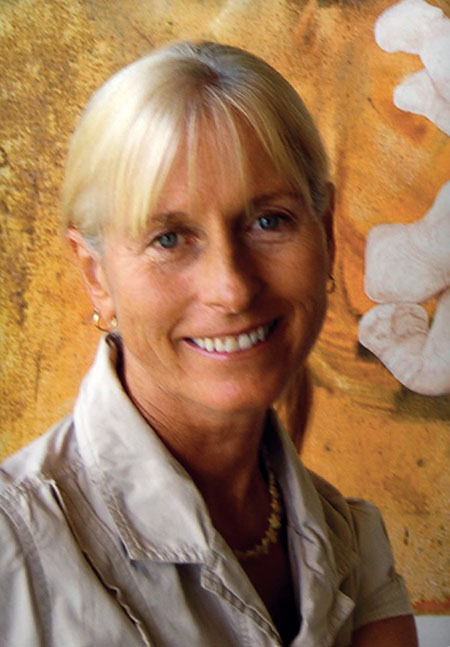
At home on the Big Island, she and her human partner are passionate about their work with stained glass and mosaic, particularly in church buildings.
“I always had a penchant for churches, even as a little girl,” she said. “In school I took classes in stained glass and crafting classes, made mirrors, windows, boxes, and I just kept going. When I got to Honolulu in 1980, I was offered a commission-based job as a designer for Ka Hale Ani Ani [House of Glass].”
“The work has to be cut-able,” she said, “and it has to be elegant. Otherwise it looks hokey. My real talent was design…When I got to the Big Island, I met Lamar—and he is crackerjack,” she said. “He doesn’t want to do the designing; he doesn’t draw. He loves to fit, cut and craft, and he understands and appreciates the qualities of glass.”
O’Neill holds a Bachelor of Fine Arts degree, summa cum laude, from Pratt Institute in New York. A prolific artist and muralist, her works grace public spaces such as the Campus Center at University of Hawai‘i at Mānoa, The Lodge at Koele, Hawai‘i Maritime Center, and many others. She also has a Masters Degree in Social Ecology from Goddard College in Vermont, and many of her works focus on endangered species.
“She’s a fine artist in the fine arts sense,” says partner Lamar Yoakum, “I’m pretty good at mechanical things and putting the glass together.” Yoakum, originally from Texas, began doing stained glass as a hobby. “I took some classes like the one I teach now,” he said. “I never did it professionally—just because I enjoyed it. I’d worked with different designers, and then saw her work and we decided to work together. Our first time was the church windows in Waimea.” Thus, Yoakum-O’Neill (“Yokomo”) Stained Glass and Mosaic was born. “It’s not complicated in the sense of what has to be done. I look at each piece of glass and ask ‘what does it do for the whole piece?’” said Yoakum. Does it look like a flower petal or just a blob? It’s like grains of wood.”

The process actually begins with an in-depth meeting with their clients. They exchange ideas and inspiration, get a sense of the space, essential elements and the purpose of the piece, then they meditate and allow images to emerge before O’Neill begins sketching. She’ll translate the pencil drawing into a watercolor rendering and “color call-out,” working with Yoakum to pick a range of colors appropriate to the work. Yoakum then selects the glass, cuts and pieces the design together using the “Tiffany method” of wrapping each selection with thin copper foil and soldering it together. The Tiffany method is a 19th century process developed by Lewis Comfort Tiffany, son of famed jeweler Charles Lewis Tiffany. His method and his use of “opalescent glass” rather revolutionized the art of stained glass.
Prior to the invention of opalescent glass, artists used clear, solid colors onto which details such as faces could be painted. Combining colors to create opalescent glass generates different textures and effects, resulting in a look that is more “alive,” with a far wider range of hues and unique three-dimensional qualities. Tiffany adapted his techniques to lampshades and capitalized on the popularity of new electric lighting for his wealthy clients.
“Opalescence has to do with the way the glass transmits the light,” says Yoakum, “and the way it’s annealed, whether it’s pulled out across bars or laid out on a table to cool. The color goes in loops, whorls and more interesting patterns. You can also ladle one color out, pour another color on top of it, up to four or five different colors, and it ends up changing characteristics.”
Yoakum purchases the glass medium from Honolulu or mainland vendors in large sheets. “I can get small pieces here but they don’t always allow me to pick what I want,” he says, “The area I need to use might be right in the center.”
“We use a lot of Youghiogheny Glass,” said Yoakum, “It’s very close to Tiffany.”
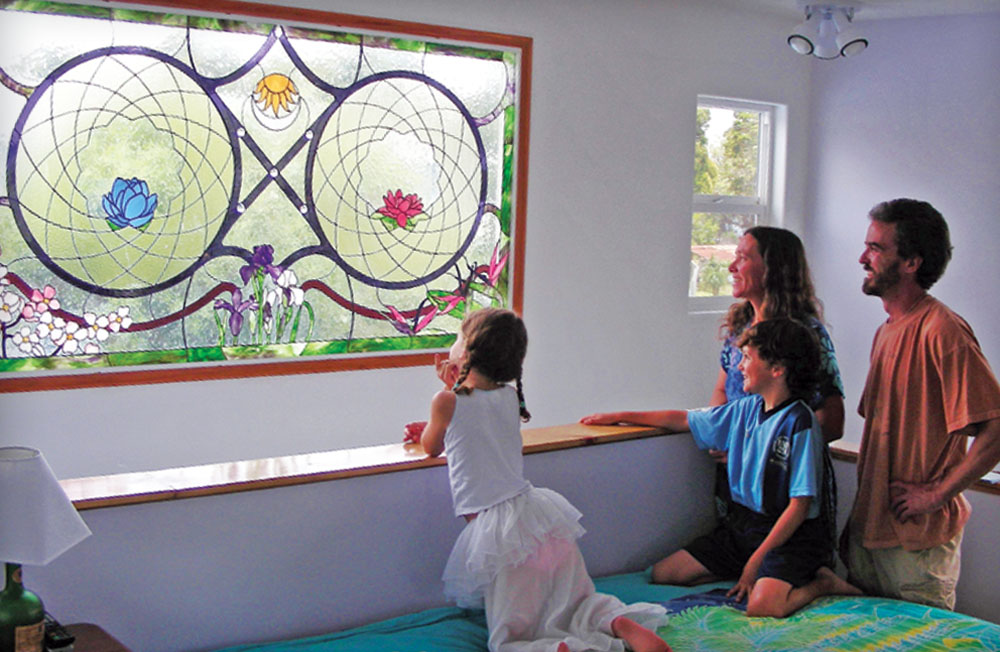
Stained glass as an art form existed in ancient Egyptian and Roman cultures. Painted alabaster windows in 4th and 5th century Christian churches may be the ancestors of stained glass, but five windows in Germany’s Augsburg Cathedral are the world’s oldest, dating from the 11th century. In the Gothic Age, architects of the great cathedrals used stained glass to block out the light and external distractions, as well as inspire and delight the worshippers inside.vRenaissance Man archetype Leonardo da Vinci was fascinated by the colors and effects of stained glass. He has been quoted as saying, “The power of meditation can be 10 times greater under violet light falling through a stained glass window of a quiet church.”
“It’s a beautiful quote, poetically written,” said O’Neill. “Of course it was known by the church, which should say something to everyone about their home. Light through glass affects the quality of glass; light comes through it to you and affects you.”

One of Yokomo’s recent installations is in the Waimea home of Sean and Valerie Harmon. “We generated some ideas and bounced them around with Calley,” said Sean, “and she came back with some sketches and now we have this huge, beautiful stained glass.” A gift from Valerie’s mother as part of their new house addition, the window is symbolic of their family life.
“The sun and moon represent my wife and me, our wedding,” said Sean. “And the pink and blue lotus flowers are for our children. My mother-in-law is represented by her favorite flower, the bird of paradise, and my mother, dogwood, because she’s from Virginia.” “We met with Calley numerous times,” said Valerie, “We were all over the place as far as ideas. But she did some meditation and the Celtic knot in the center and the lotus flowers came from that. We’re very happy with it. In the morning it projects flecks of rainbows on the walls.”
A public example of O’Neill and Yoakum’s artistry is at the “butterfly building,” home of the “Green with Envi” shop and Big Island Substance Abuse Council on Mamalahoa Highway. You may have seen the giant specimens on the outside, but the inside story is a stunning study of Hawaii’s native butterflies, the King Kamehameha and the Hawaiian Blue, and the Kaua’i Moth.
“There are very few but they are very pretty and pretty much unknown,” said O’Neill. “Not many people realize they are actual Hawaiian natives. They know kalo and koa trees; they know different ferns and flowers. We’re so happy that more people are now becoming aware of these beautiful Hawaiian butterflies.”
“Pretty much everybody loves stained glass and everybody thinks they can’t have it,” said O’Neill. “There are different levels, and it can be quite affordable.” More and more, she and Yoakum are working with mosaics for indoors and out. “We did a curved wall for a swimming pool that was beautiful,” said O’Neill. “It’s not going to fade, and there’s no maintenance ever, not like paint.”
“Glass is a great medium, a mystic medium,” said O’Neill.
“Stained glass will teach you one thing,” said Yoakum. “You learn to live in the now. When it’s broke, it’s broke.” ❖
For more information on stained glass works or Lamar’s classes, visi www YokomoStainedGlassandMosaic.com or call 885.0609.
Email Catherine Tarleton at catherinetarleton@gmail.com.
